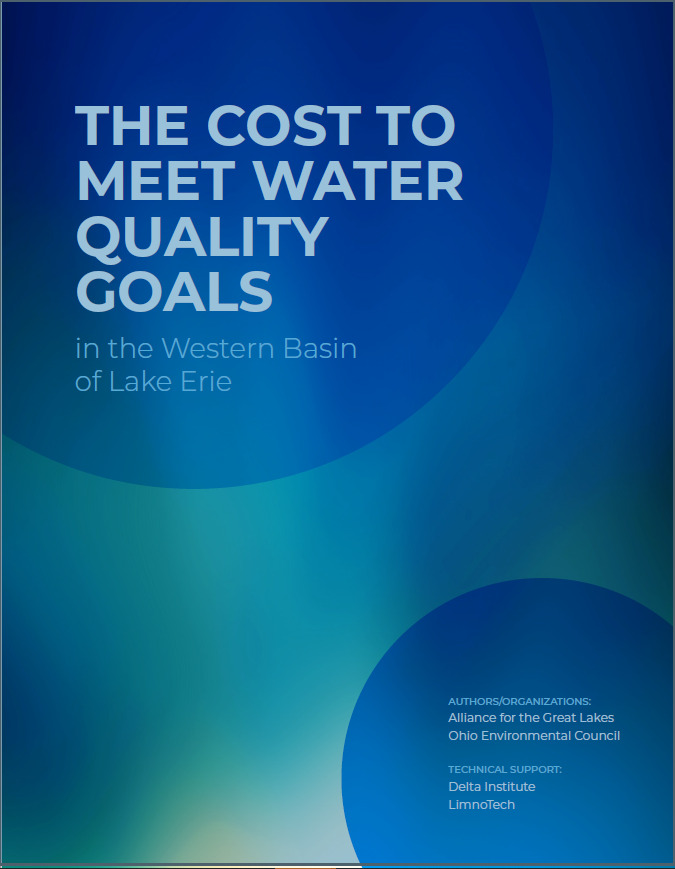Harmful algal blooms plague western Lake Erie each summer, threatening drinking water supplies, recreation, and the regional economy. Nutrient pollution, specifically phosphorous, flowing off agricultural lands is the largest unchecked source of pollution driving these massive algal blooms.
In 2015, the Governors of Ohio and Michigan and the Premier of Ontario committed to reducing phosphorus inputs to Lake Erie by 40% by 2025. Interim targets set for 2020 were not met. Data consistently shows that it is unlikely the 2025 goal will be met.
On February 14, 2023, the Alliance for the Great Lakes and Ohio Environmental Council released a new study – The Cost to Meet Water Quality Goals in the Western Basin of Lake Erie .
Project partners examined the additional agricultural conservation practices needed and associated costs for Michigan and Ohio to implement them in the Western Basin of Lake Erie to meet water quality goals.

The study found:
- Current investments in Ohio and Michigan aimed at reducing phosphorous runoff from agricultural lands are woefully inadequate.
- If funding and conservation practice adoption continue as they currently are, the study found that there is no pathway for Michigan and Ohio to meet the 40% nonpoint source phosphorus reduction goal.
- Meeting the 40% phosphorus reduction goal is possible. But it will require significant, sustained additional funding, by several orders of magnitude annually, along with major increases in conservation practice adoption, also by orders of magnitude annually, and in some cases shifting the types of conservation practices.
Bold action is needed to meaningfully reduce western Lake Erie’s harmful algal bloom problem that threatens our drinking water, recreation, and regional economy.
If Ohio, Michigan, and the federal government are truly committed to protecting the health of our communities and the lake, elected leaders and agency officials must recognize the scale of the problem and what it will take to solve it.
The study highlights shortcomings in current practices and funding and provides insights into what is needed in Michigan and Ohio to reduce phosphorus inputs to Lake Erie by 40%.
Major shifts needed in the types of conservation practices utilized
Annual, in-field conservation practices are not sufficient to meet water quality objectives – even when implemented on 100% of agricultural acres in the western Lake Erie basin. The study suggests that annual in-field practices, such as cover crops, no-till, and crop rotation, cannot be scaled sufficiently to meet the water quality goals of the western basin.
Changes are needed in the types of conservation practices funded as part of this effort. State and federal agencies must invest sustainably in edge-of-field structural practices like constructed wetlands and two-stage ditches to meet water quality goals in the Western Basin of Lake Erie. These practices deliver more consistent phosphorus reductions year-over-year and are not easily abandoned like annual in-field practices.
The study finds that Michigan and Ohio will need to increase the number of acres using annual in-field and edge-of-field structural conservation practices to meet water quality goals. In-field practices like cover crops and crop rotation will need to be increased by up to 8 times. Edge-of-field structural practices, such as wetlands and two-stage ditches, will need to be increased by up to as much as 25 times current levels.
Significant, sustained new investments needed
The study found that state and federal agencies currently are underinvesting by several orders of magnitude. Michigan will need to increase funding by $40-65 million over current spending, a more than six-fold annual increase from current levels. Ohio will need to roughly double current annual funding levels by $170-250 million over current spending.
Funding should be prioritized for practices that make quantifiable, meaningful reductions in phosphorus flowing off agricultural lands. For instance, the H2Ohio program, initiated by Governor DeWine in 2019, has significantly invested in solutions to phosphorus nutrient pollution. H2Ohio dollars have funded wetland construction and incentivized in-field practices. But to truly implement these practices at the scale needed to make meaningful phosphorus reductions, programs like H2Ohio will need to be funded at much higher levels and, over the long term, beyond the biennial budget cycle.
Elected leaders and agency officials must acknowledge the scale of the problem, appropriate adequate funding, and develop strong plans for meeting nonpoint source phosphorus reductions.
For more information, download the full report and fact sheet.

The study, led by Alliance for the Great Lakes and the Ohio Environmental Council, with technical support from LimnoTech and Delta Institute, used readily available, peer-reviewed information, data, and literature to create modeling scenarios.
The project team designed a process to estimate needed agricultural conservation practices in the western basin of Lake Erie and the associated costs for both Michigan and Ohio to implement these needed practices.
